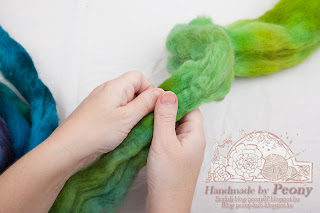The last time I’ve
written about what tools would we need when the irresistible urge to spin yarn
hits us? Now, if we already have a spindle (or a spinning wheel) we need some
fiber to spin.
What natural fibers
could be spun into a yarn?
Cotton, linen, hemp,
silk, and the hair of different kind of animals. The most known of these are
sheep, angora bunnies, alpaca, and a few other like camel, llama, yak, some
goat types. In Hungary traditionally linen and hemp is spun, most of old wheels
that can still be found is built for them, and of course wool. I already knew
how to spin, when I learned that my grandma not only embroidered, crocheted and
knitted, but also spun. She kept angora bunnies (their hair was called the
cashmere of the poor), and there was a story about a year, when she taught the
daughter a well of farmer family to spin, and she was paid in freshly cut wool.
They washed it, carded (had it carded), in the fall my grandma spun it, then in
the winter knitted it and sold it.
In my country there
is only a few type of wool available, even less that is acceptable quality,
good quality is only a small portion of that.
On the other hand, through the internet one can get almost anything,
from the simplest to the most special materials. But, it can be tricky to
figure out what to get.
I will steer away
from the cotton and linen, as these need different techniques. If one has an
irresistible urge to spin cotton search for the spinning cotton/linen keywords.
So, let’s look at
animal fibers, specifically wool. Wool fibers are very resilient, and elastic,
they can be bent about 30000 times without damaging it.
On the surface of
the wool fiber there are tiny scales, these hold on to each other, in felting
they are softened with soap, and can be pressed even closer to each other. The
fiber itself is like a spiral, which makes it very warm, as air is trapped not
only under the scales, but also between the spiraling fibers. These spirals
return to their shape, therefore wool is elastic, and keeps its shape.
The hair of alpacas
is hollow, like a tube, but its surface is smoother, so it is warmer than wool,
but instead of holding the shape it drapes. If we plan to use it for something
where drape is needed it can be used in itself, or combined with silk, if we
need something that holds its shape, it can be mixed with wool. Because of its
smoother surface alpaca is more difficult to spin than wool.
What “micron
number” means. Micron, or micrometer is one-millionth of a meter, one-thousandth of a millimeter, 0.001 mm.
The less the micron number is, the thinner, finer the fiber is.
The most known wool
type is merino wool, which usually has a micron count of 16-30.
What should be
selected for the first practice spins? In my experience medium wool (25-35
micron) with medium fiber lengths works best.
Merino usually
thinner than this, finer and softer, and it kind of slides and sticks at the
same time. BFL (Blue Faced Leister), Falkland Polwarth, is easier to spin,
while still soft. A Corriedale, Coopworth, Jakob, Coburger and similar wools even
easier to spin, but here the difference is softness can be felt.
Naturally, as with
crafts generally, there are no hard set rules. If you have merino at hand for
the first time, or you want to learn spinning because you have a flock of
alpacas, and unlimited supply of their hair, go for it.
If we are searching
the internet about wool, we sooner than later will bump into gorgeous hand dyed
stuff. Through dyeing, packing, storing, shipping wool can compress, and stuck
together, making the fiber difficult to spin. What can we do when this happens?
First open the
fiber with your hands across the fibers perpendicular to the how the fibers
stand (with small tearing movements).
Then parallel to the fibers , with your
hands about 30cm apart (depending on the length of the individual fibers) pull
it apart slightly, so the fibers slide on each other a bit.
This should be done
carefully, as you can easily pull too much and tear the roving apart. This only
problematic at handling/storing the roving a but not at spinning it.
Just for an interesting bit...look how much a pretty compacted fiber can be opened up.
Happy spinning!
(Photos: Tamás Rigó/Veronika Nyerges)

















1 comment:
This was a very interesting post! I have dyed fibre and had it end up like the semi-felted one you show here. It was very difficult to spin. I should have spent more time with it before spinning, doing what you demonstrate here. Instead, I just tried to pull it apart as I went along.
Post a Comment